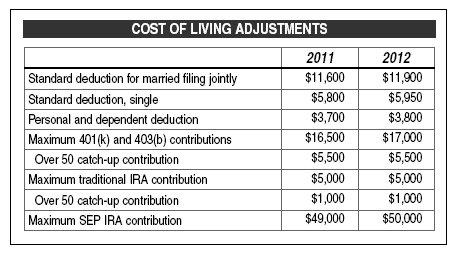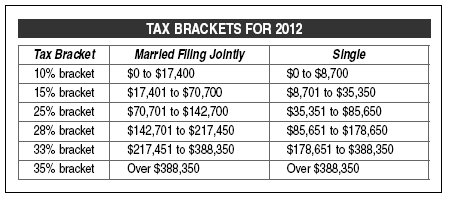As you complete your 2011 tax return checklist, you may not have considered the last step: thinking about your 2012 taxes. Avoid the temptation to ignore taxes until this time next year.
The good news is that most taxpayers will be affected only by a few small changes for 2012. However, many tax provisions are set to expire at the end of the year, which makes it an important one for planning.
You may have noticed one change already. Beginning with the 2011 tax year, custodians and broker-dealers were required to report realized gains and losses from sales of stock to the Internal Revenue Service on Form 1099-B. If you saw a heftier 1099 this year, this new requirement is the reason. Starting in 2012, custodians and broker-dealers will be required to report realized gains and losses for mutual funds and exchange-traded funds as well. Not all custodians and broker-dealers have found preparing for these new reporting requirements a smooth process; you may want to check their cost basis records carefully against your own.
Individuals also face new reporting requirements for realized capital gains and losses starting with their 2011 tax returns; they must now report sales and exchanges of capital assets on Form 8949. The totals from this new form are then entered on Schedule D of the Form 1040. Note that on Form 8949, you must indicate whether the transactions and cost basis were reported to the IRS on Form 1099-B. It should be clear from Form 1099-B what was reported to the IRS. However, if in doubt, confirm the amount with the issuer and consult your tax adviser.
Another new reporting requirement for the 2011 tax year is Form 8938, which is used to report certain foreign financial assets, such as a foreign bank account. Form 8938 is only required if the value of the assets exceeds a certain threshold. A married couple residing in the United States is required to file if their foreign financial assets exceed $100,000 on the last day of the year or $150,000 at any time during the year. The threshold is higher for taxpayers living abroad. Form 8938 is filed with your tax return and does not replace the Foreign Bank and Financial Accounts Report (TD F 90-22.1).
For 2012, the IRS has made its customary cost-of-living adjustments to the standard deduction, personal exemption and maximum retirement contribution amounts. Slight adjustments have also been made to tax brackets to account for inflation. A summary of these changes is provided in the tables below.
Inflation is not the only, or even the most notable, factor to consider when anticipating changes for the next tax year. The potential expiration of current law, and the possibility of new law, may have much greater impacts.
Perhaps the most notable piece of recent tax legislation is the extension of the payroll tax cuts, which is remarkable mostly because lawmakers were able to agree on it.
Employers and employees both pay a portion of payroll tax, which funds Social Security benefits to retirees. The Tax Relief, Unemployment Insurance Reauthorization, and Job Creation Act of 2010 reduced the employee withholding rate from 6.2 percent to 4.2 percent for 2011. A two-month extension was passed in December 2011, and in February 2012, the Middle Class Tax Relief and Job Creation Act of 2012 extended the lower rates through the end of the year.
For 2012, the Social Security tax applies to the first $110,100 of wages and net self-employment income an individual receives. This puts the maximum tax break at $2,202. The government expects nearly 160 million workers to take home an average $714 more than they would have had the cuts expired.
Such extensions may become the exception, rather than the rule, this year. With the economic recovery limping along and an election approaching in November, lawmakers have been hesitant to create any new (unpopular) taxes. However, they did let several tax breaks expire at the end of 2011, and more are scheduled to disappear at the end of 2012.
One particularly popular tax provision that is no longer available is the ability to donate to charity from an Individual Retirement Account. IRA owners over age 70 1/2 could previously donate up to $100,000 a year to charity directly from their IRAs. That donation would count toward the owner’s required minimum distribution. Such donations were not tax deductible but were not included in income, either. Therefore, they did not trigger taxes on Social Security payments or higher Medicare premiums, as a traditional distribution would. Ideally, Congress will retroactively reinstall this provision, but that decision might not come until the end of the year, as it did in 2010. Until then, it cannot be counted on.
The much-debated “Bush-era tax cuts” are currently scheduled to expire at the end of 2012. Income tax rates are then scheduled to rise, ranging from 15 to 39.6 percent, up from the former rates ranging from 10 to 35 percent. Long-term capital gains, which are currently taxed at a maximum 15 percent rate, will be taxed at a maximum of 20 percent. Qualifying dividends will be taxed at ordinary rates, instead of the current, more favorable 15 percent. If the tax cuts have not been extended by the end of the year, it may make sense to accelerate income into 2012, to take advantage of the disappearing lower rates.
This year will also be the last for the American Opportunity Tax Credit, which can be claimed for expenses for the first four years of postsecondary education, unless it is extended. Qualifying expenses include not only tuition, but also course-related books, supplies and equipment. The credit’s predecessor, the Hope Credit, only covered the first two years of postsecondary education and a narrower category of expenses. The maximum American Opportunity Tax Credit is $2,500, and 40 percent of the credit is refundable, meaning you can receive it even if you have no income tax liability.
Also at the end of the year, the estate tax is scheduled to revert to the rules from 2001. The current estate tax exclusion of $5.12 million will decrease to $1 million, barring an extension or overhaul of the estate tax. Again, it is possible that we will have to wait until December to have a clearer picture of the estate tax for 2013. Flexibility is essential for any estate plans made in this uncertain and dynamic environment.
Given that it is an election year, and given the fiercely partisan climate in Washington, it is unlikely that we will see any major changes to the tax law. Any momentum for overhauling the tax code died with Herman Cain’s campaign. For now, the focus will remain on extensions for expiring provisions or retroactive reinstatements of previously expired ones.
Maybe the best tax gift for this year is the filing deadline, which has been pushed back to April 17. The traditional deadline, April 15, falls on a Sunday, and Monday, April 16, is Emancipation Day. You now have two more days to cross t’s, dot i’s, and make sure you are in compliance with any new tax legislation. As you finish up, don’t forget that very last checkbox: Make the most of 2012 for planning, and treat yourself to a less stressful 2013.










